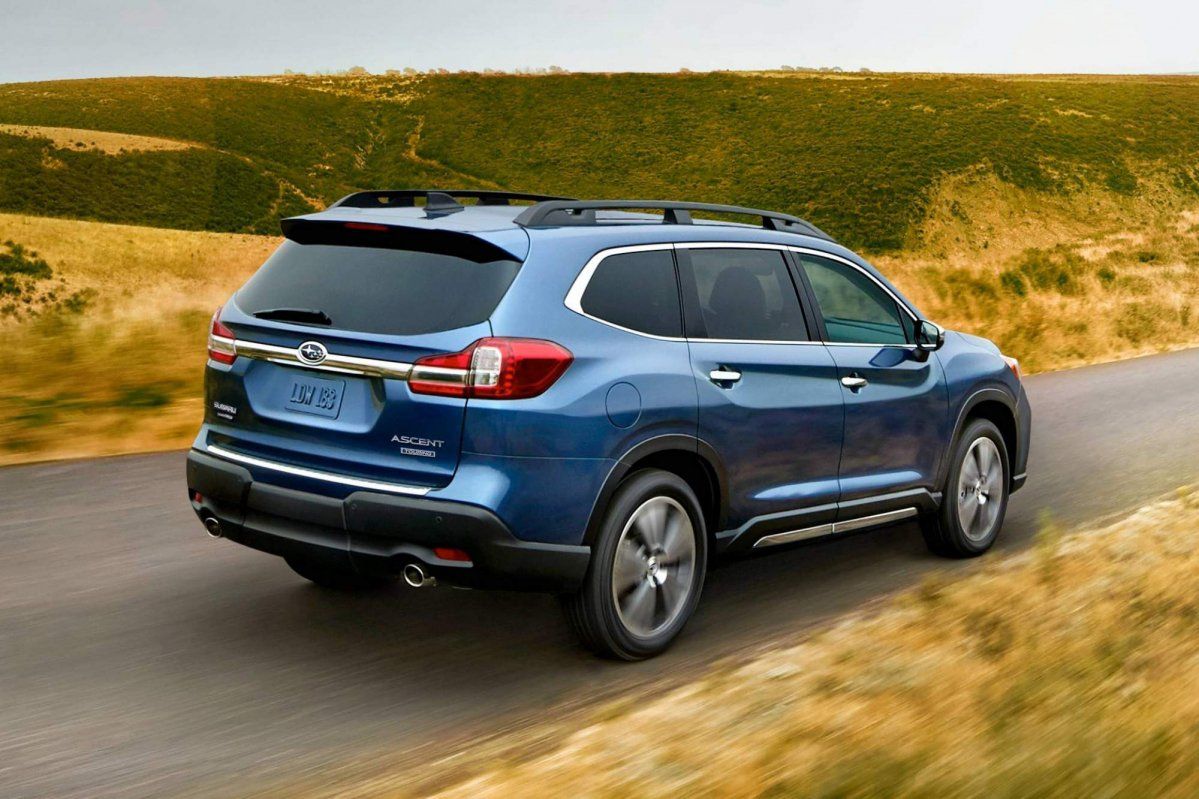When shopping for an SUV, interior space often plays a major role in the decision-making process—but it’s not just about legroom or cargo capacity. For taller drivers and passengers, headroom can be a make-or-break factor.
A cramped ceiling can turn even the most luxurious SUV into an uncomfortable ride, especially on longer trips. Conversely, generous headroom can elevate your daily commute or weekend road trip into a far more pleasant experience.
That’s why it’s essential to consider vertical space when comparing options, whether you’re tall yourself, frequently transport taller passengers, or simply value a more open and airy cabin feel.
In this article, we’ll highlight five SUVs that stand out for their impressive headroom, giving taller occupants room to sit comfortably without slouching or grazing the ceiling.
5 SUVs With the Most Headroom
On the flip side, we’ll also take a closer look at five models that fall short—literally—when it comes to overhead space, which could be a dealbreaker for some buyers.
Whether you’re navigating the SUV market for personal use, a family vehicle, or just want to know which ones might leave your hair brushing the headliner, this guide will help you find a ride that truly fits—top to bottom.
1. Ford Expedition Max – 42 inches (Front Headroom)
The Ford Expedition Max is a full-size SUV built with serious space in mind. With approximately 42 inches of headroom in the front row, even the tallest adults can ride in comfort.
Rear passengers also enjoy generous room, making it a favorite for families and road-trippers. Its boxy shape and high roofline contribute to this spaciousness, and even the third row accommodates adult passengers easily.
Hippos may be a fascinating sight at the zoo, but it’s clear that animals of such immense size aren’t suited for life behind concrete walls. If full-size SUVs are the automotive equivalent of hippos, then dense city centers are their unnatural habitats.
Weighing in at 5,968 pounds and stretching nearly 18.5 feet in length, almost seven feet in width, and standing 6.5 feet tall, the newly redesigned 2025 Ford Expedition Max is undeniably massive.
This three-row SUV isn’t designed for stop-and-go traffic or cramped parking garages—it’s built for the open road. On expansive stretches of highway, the Expedition Max’s spacious, living-room-like cabin, generous cargo area, and thoughtful driver-assist features can truly shine during long-haul family adventures.
Now entering its fifth generation, the 2025 Expedition Max has grown nearly two inches taller than before. Yet, interior dimensions across its three rows remain largely consistent, meaning it still lags slightly behind the GMC Yukon XL in terms of sheer spaciousness.
That said, once you’re actually seated in the Expedition Max’s cushy second- or third-row 40/20/40 split-bench seats, the story shifts. While the third row might feel a bit tight for adults over six feet tall, few will find it truly confining.
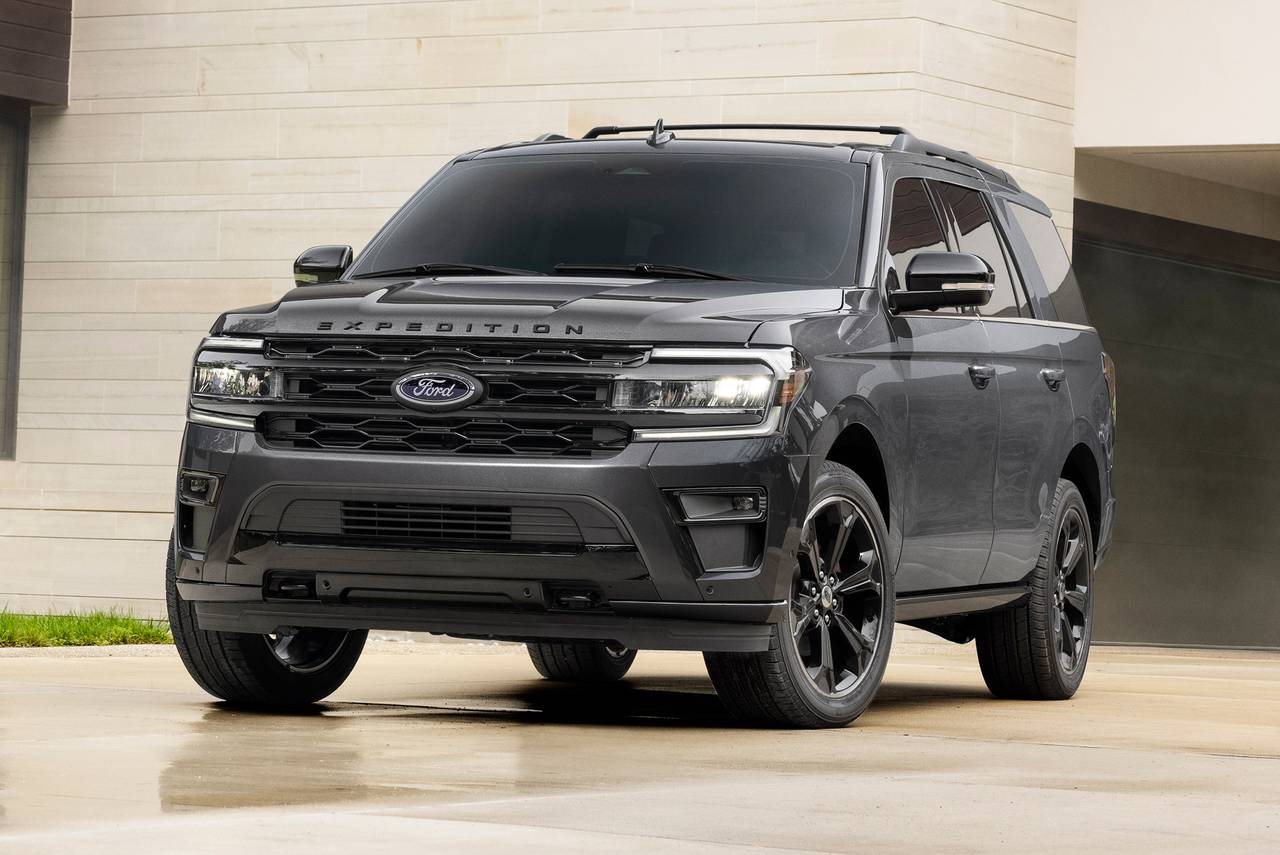
Opting for second-row captain’s chairs—available as part of a $4,215 package on the base Active trim—reduces seating from eight to seven but meaningfully upgrades comfort for those in the middle row.
Though it’s nearly a foot longer than the standard Expedition, the Max doesn’t increase legroom for passengers. Instead, that extra length is entirely devoted to cargo.
With all seats upright, the Max offers 36 cubic feet of space—14 more than the regular Expedition. Fold the third row down, and you get 75 cubic feet. With both rear rows flat, total cargo capacity climbs to an impressive 123 cubic feet, just one more than last year’s model.
That added practicality comes with a $3,000 price bump over the base Expedition, placing the Max at $66,995 for the Active trim. This pricing is competitive within its class—about $2,000 above the Jeep Wagoneer L and $5,400 below a similarly equipped GMC Yukon XL.
However, the price tag climbs quickly. A fully optioned King Ranch Max can top $95,000, entering Lincoln Navigator territory. Our Platinum Max test vehicle, which included only the $6,545 Stealth Performance package, came in at a hefty $85,970.
If there’s one theme that runs throughout the Max’s higher trims, it’s pricey packages. The Platinum Ultimate bundle, for example, costs $13,570 and includes the high-output V-6, adaptive dampers, 24-inch wheels, upgraded interior materials, and a host of aesthetic enhancements. But given that many of the performance upgrades and interior features can be found in less expensive packages, it’s a tough spend to justify.
Visually, the 2025 Expedition leans further into a luxury look. A smoother front grille is now outlined with a continuous LED light strip, lending a more premium appearance.
The rear design has been softened as well, with reworked taillights that blend seamlessly into the quarter panels and a new split liftgate. This updated liftgate features independently opening upper and lower sections—the lower acting as a barrier for rolling cargo when raised, and as a seat for sideline spectating when lowered.
Stepping into the driver’s seat—via the powered running boards—reveals some of the most dramatic changes inside. The new dashboard ditches the traditional 12.4-inch instrument cluster in favor of a wide 24.0-inch display that sits within a canoe-shaped recess at the base of the windshield.
Combined with the new squircle-shaped steering wheel, this setup opens up the front cabin, creating a futuristic and expansive feel from behind the wheel.
Also Read: Top 10 Most Reliable Used Cars You Can Buy for Under $10,000 in 2025
2. Hyundai Palisade – 40.7 inches (Front Headroom)
The Hyundai Palisade combines luxury and practicality with a modern design that doesn’t compromise on interior dimensions. Its front-row headroom of 40.7 inches is impressive for a midsize SUV, and even the second row isn’t far behind.
The Palisade’s upright seating position and adjustable headrests contribute to a more open, airy cabin experience. The 2025 Palisade stands as Hyundai’s largest SUV and is an excellent choice for anyone needing more space than what’s offered in the smaller Tucson or Santa Fe models.
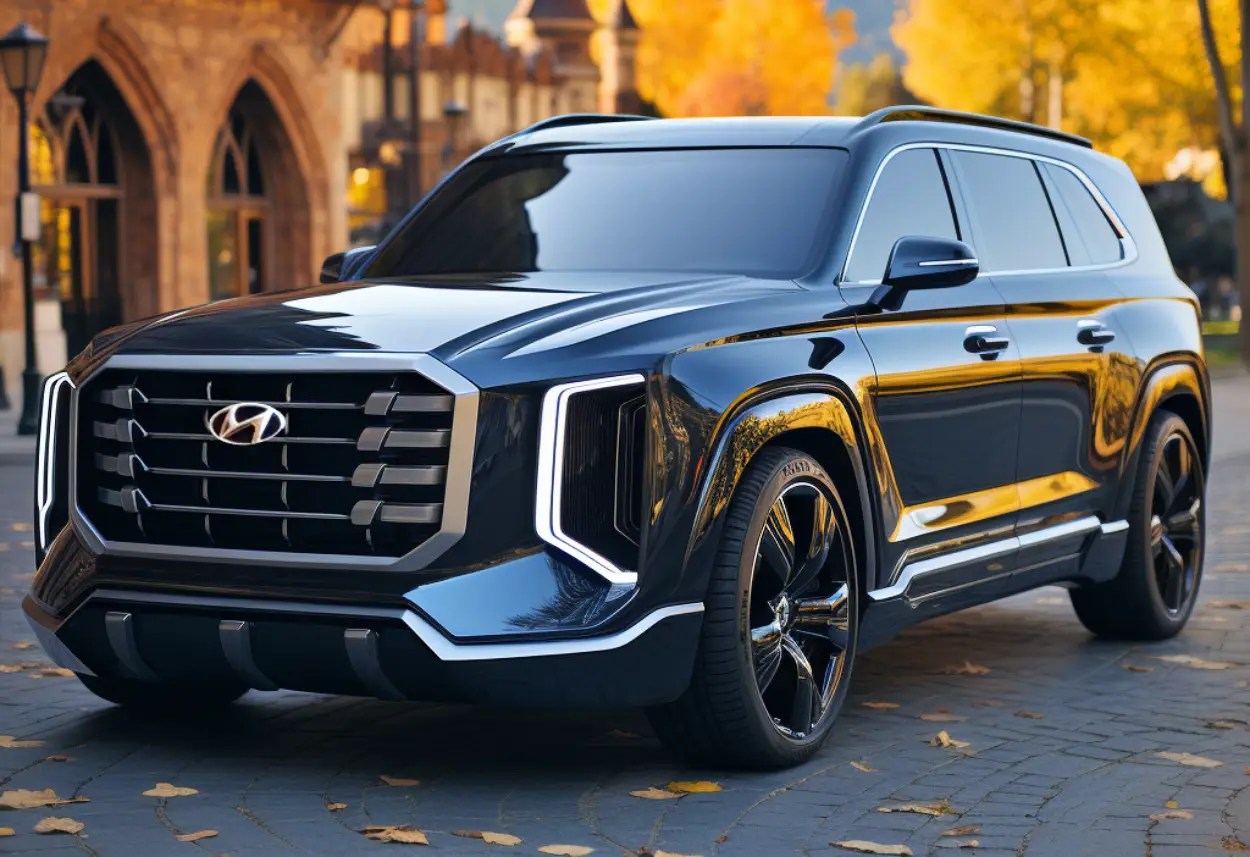
This three-row SUV comfortably accommodates up to eight passengers and comes in seven different trim levels, each catering to a wide range of price points. For those shopping with cost in mind, the Palisade’s entry-level pricing is especially appealing, ranking among the most affordable in its class.
At the other end of the spectrum, buyers with more generous budgets will find the higher trims surprisingly upscale, delivering features and refinement that rival luxury-brand SUVs. Since its debut in 2020, the Palisade has consistently remained one of our top picks in the three-row midsize SUV segment.
3. Chevrolet Tahoe – 42.3 inches (Front Headroom)
The Chevy Tahoe is another full-size SUV known for its comfort and space. With over 42 inches of front headroom, the Tahoe delivers on vertical comfort.
Its tall stance and squared-off roofline give occupants plenty of breathing room, and the optional panoramic sunroof doesn’t detract significantly from head clearance. For 2025, Chevrolet has revised the Tahoe’s standard suspension system, delivering a noticeably smoother and more refined ride.
Whether you’re driving on uneven pavement or rougher terrain, the Tahoe remains composed—though models equipped with the optional 24-inch wheels might sacrifice some ride comfort. Despite its size, this full-size SUV handles with confidence, and the steering feels nicely balanced and responsive.
When properly equipped, the Tahoe can tow up to 8,400 pounds and also proves capable on light to moderate off-road trails. If you’re planning more rugged adventures, the Z71 trim is your best bet. It comes outfitted with features like hill-descent control, red recovery hooks, and all-terrain tires that enhance its trail-readiness.
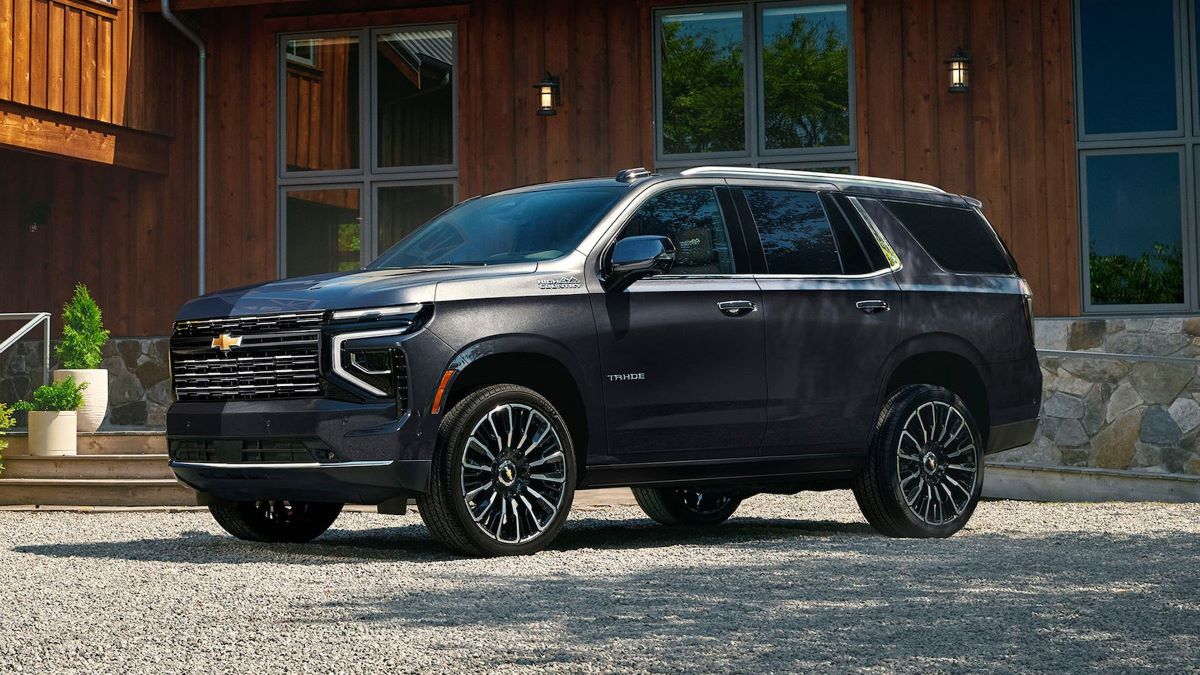
Under the hood, buyers have three engine options. The base engine is a 5.3-liter V8 delivering 355 horsepower and 383 pound-feet of torque—more than sufficient for most needs. For those wanting more muscle, there’s an available 6.2-liter V8 with 420 horsepower and 460 pound-feet of torque, though it comes with a thirstier fuel appetite.
New for 2025, the 3.0-liter turbodiesel inline-six sees a bump in power, now producing 305 horsepower and 495 pound-feet of torque. This engine delivers performance on par with the stronger V8 but with significantly better fuel efficiency.
According to EPA estimates, the 2025 Tahoe achieves between 14 and 15 mpg in the city and 18 to 20 mpg on the highway with the V8 engines. Official numbers for the updated turbodiesel haven’t been released yet, but the 2024 model posted impressive ratings: 20 to 21 mpg city and 26 to 28 mpg highway, depending on configuration.
4. Subaru Ascent – 41.3 inches (Front Headroom)
The Subaru Ascent is a great option for those who want standard AWD and a roomy interior. At 41.3 inches of front headroom, it comfortably fits taller individuals without needing to adjust the seat too far down.
The second and third rows offer generous headroom as well, making the Ascent an excellent family vehicle.
The Ascent may not be the most exhilarating SUV to drive through winding roads, but it handles with a solid sense of control and composure for a vehicle of its size. The steering is light and precise, making it easy to maneuver in tight spots or parking lots. While there is a bit of body roll when taking corners, the Ascent maintains a stable and grounded feel throughout.
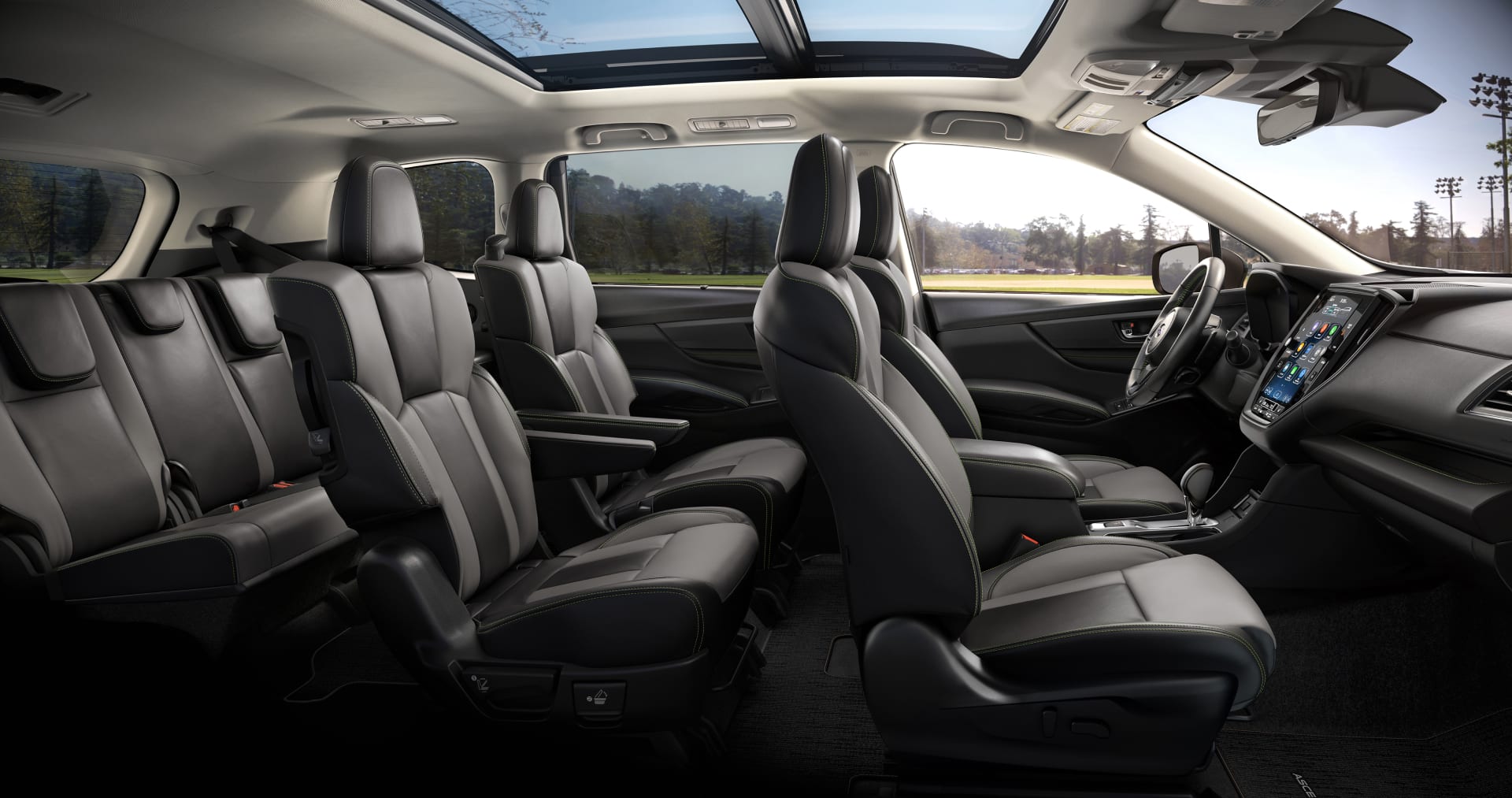
Ride comfort is a strong suit, with the suspension effectively smoothing out most road imperfections—only the roughest surfaces manage to disrupt its otherwise cushy ride. Strong brakes add to driver confidence, delivering quick and secure stopping power when needed.
Under the hood, every Ascent is powered by a 260-horsepower turbocharged four-cylinder boxer engine, paired with all-wheel drive and a continuously variable automatic transmission (CVT).
The setup offers adequate performance for daily commuting and errands, but the Ascent’s substantial weight becomes more apparent during highway merges or uphill climbs—especially with a full load of passengers on board. There’s noticeable turbo lag off the line, too.
That said, the CVT does its job quietly and efficiently, fading into the background during most driving scenarios. When equipped appropriately, the Ascent can tow up to 5,000 pounds, placing it in the average range for midsize SUVs.
Also Read: 5 SUVs With Factory-Installed Block Heaters and 5 Without Cold-Weather Prep
5. Kia Telluride – 40.9 inches (Front Headroom)
Closely related to the Hyundai Palisade, the Kia Telluride also boasts spacious headroom, particularly in the front row.
With nearly 41 inches of vertical space, the Telluride remains one of the top choices among midsize SUVs for taller drivers. Its upright proportions and flat roof help maximize interior comfort without making the vehicle look oversized.
The Kia Telluride made its debut in 2020, entering the crowded three-row SUV segment to challenge established models like the Toyota Highlander, Subaru Ascent, and Honda Pilot. But rather than simply hold its own, the Telluride quickly rose to the top of the class.
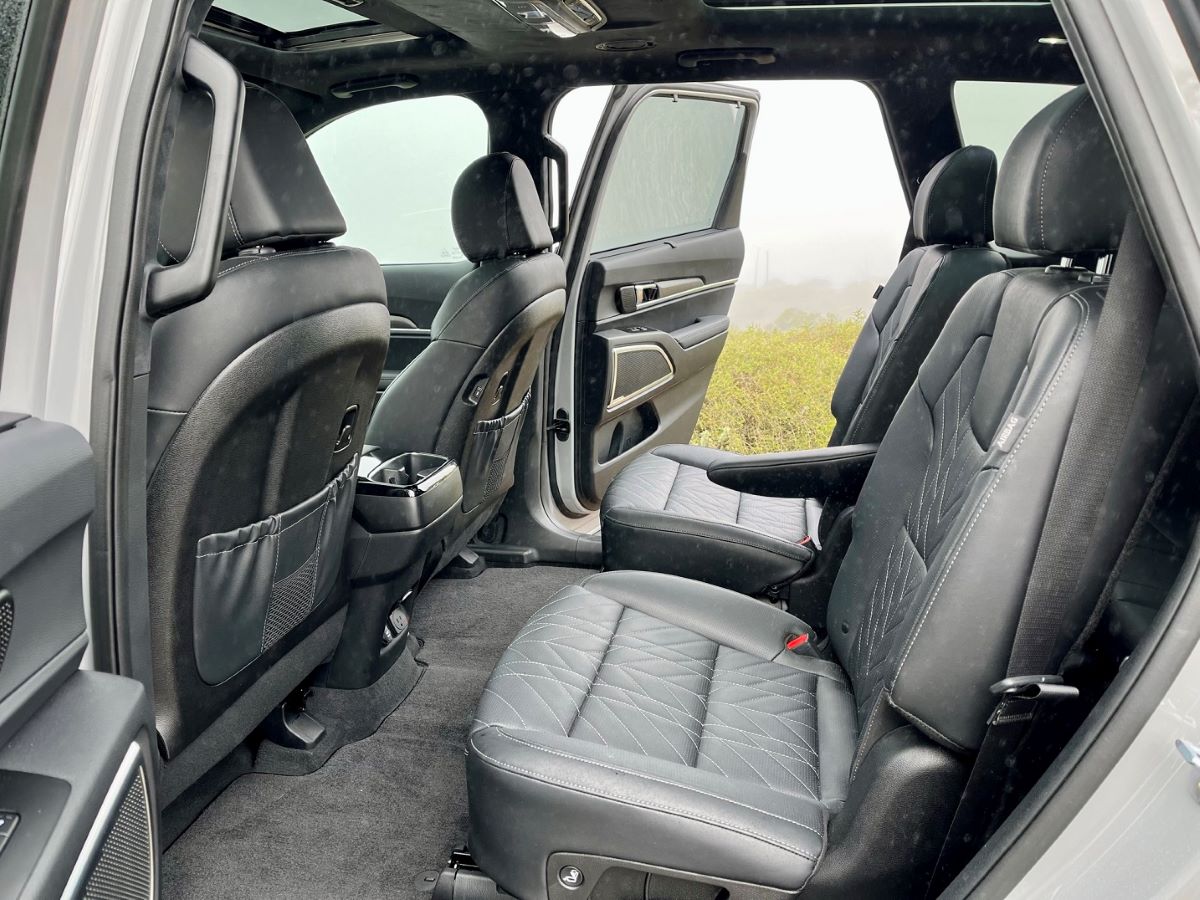
It’s not only enjoyable to drive but also impressively spacious, offering ample room for cargo and passengers alike. Its interior feels open and inviting, while the exterior styling adds to its overall appeal with a confident and refined look.
For the past five years, the Telluride has consistently set the benchmark in its category, and frankly, it’s difficult to recommend another midsize SUV over it—it really is that well-rounded.
SUVs With Tight Ceilings
While some SUVs prioritize space, others sacrifice headroom for sleek styling, sloping rooflines, or panoramic sunroofs. Here are five SUVs known for tighter ceilings that may not be ideal for taller occupants.
1. Mazda CX-5 – 39.7 inches (Front Headroom)
While the Mazda CX-5 is praised for its driving dynamics and upscale interior, it falls short in headroom. Its front headroom of just under 40 inches feels tight for taller drivers, especially when a sunroof is equipped. The sloping roofline towards the rear further reduces ceiling space for backseat passengers.
There’s a possibility that the upcoming CX-5 will adopt the newer rear-wheel-drive-based platform currently used by the Mazda CX-70 and CX-90. Such a shift in architecture would likely enhance the CX-5’s driving dynamics and overall refinement, especially if the turbocharged inline-six and plug-in hybrid inline-four powertrains from its larger siblings become available for this model.
Should Mazda take this route, it would likely push the CX-5’s price upward, aligning with the brand’s ongoing push toward premium positioning.
That move might be justified, though, given Mazda already has the similarly sized, front-wheel-drive-based CX-50 in its lineup. The existence of the CX-50 gives Mazda flexibility to allow the new CX-5 to move more upmarket, addressing the current overlap between the two models.
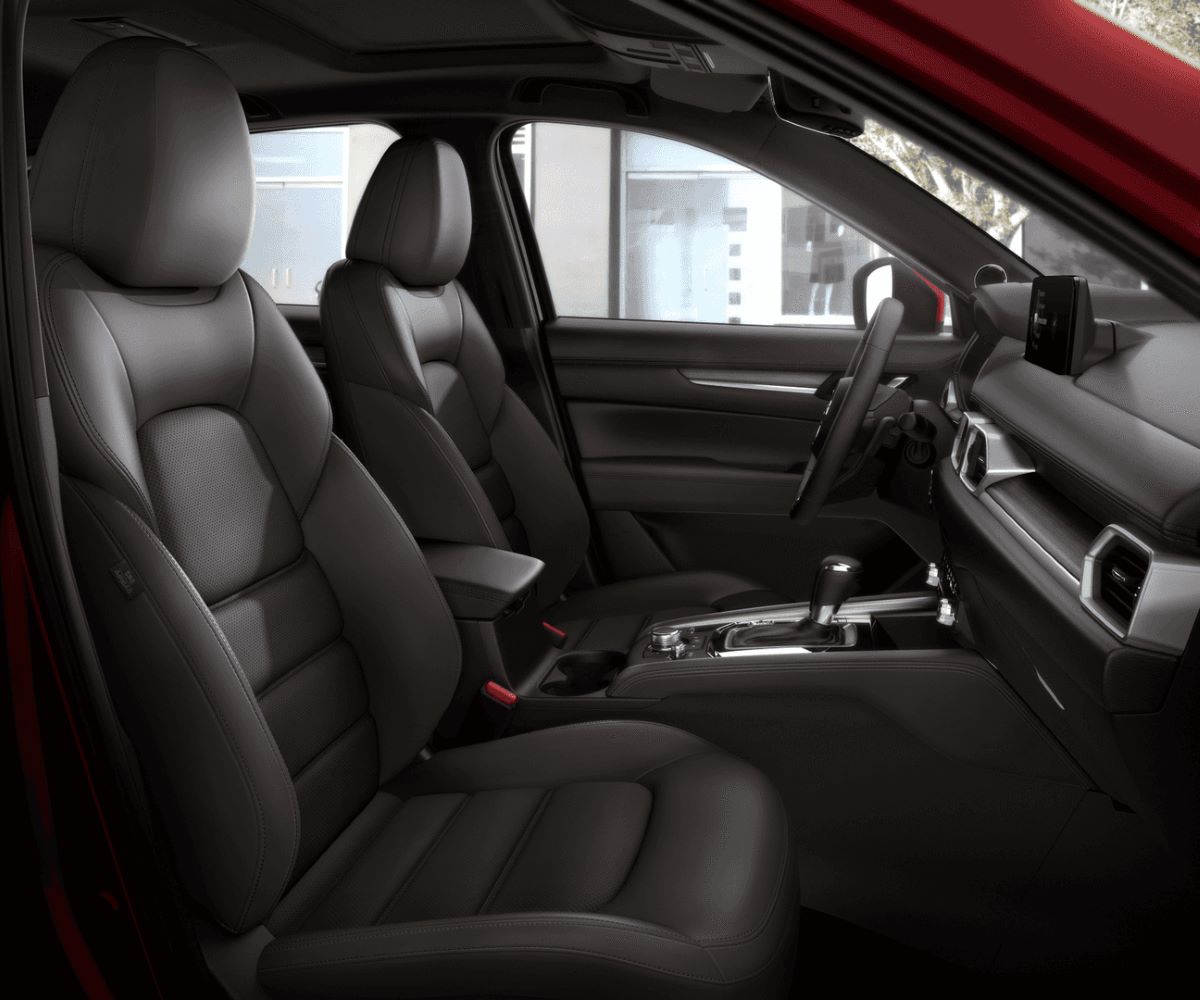
On the other hand, Mazda may opt for a more conservative update, continuing with the proven front-wheel-drive-based platform and offering all-wheel drive as an option—essentially sticking with the current CX-5 formula. This is the more likely approach for the 2026 model.
If so, engine options would probably stay close to the current lineup, with a naturally aspirated 2.5-liter and a turbocharged version of the same.
However, the Toyota-sourced hybrid inline-four already available in the CX-50 is expected to migrate to the CX-5. Mazda is also developing its own hybrid system, which could be another possibility. In either case, adding a CX-5 Hybrid is crucial for staying competitive with the 2026 Toyota RAV4, which now comes standard with a hybrid powertrain.
Following this path would help Mazda keep the CX-5 grounded in its existing price and performance range, though distinguishing it from the CX-50 may continue to be a challenge.
2. Toyota C-HR – 38.1 inches (Front Headroom)
The Toyota C-HR is a compact crossover with a coupe-like roofline, which severely limits headroom. At just over 38 inches in the front, taller individuals will find it cramped.
The rear is even worse, with the sloped ceiling and high beltline creating a claustrophobic atmosphere.
The Toyota C-HR offers a selection of two conventional hybrid petrol engines—a 138bhp 1.8-litre and a more powerful 193bhp 2.0-litre—as well as a plug-in hybrid (PHEV) version that pairs the 2.0-litre engine with a larger battery pack. Regardless of the version you choose, all come equipped with a responsive CVT automatic transmission.
Our top recommendation is the 1.8-litre variant. While it’s not built for speed—its official 0-62mph time is 10.2 seconds, about a second slower than the Lexus LBX—it still handles highway merging and overtaking with minimal fuss.
For those seeking quicker acceleration, the 2.0-litre regular hybrid is the one to consider. At our private test facility, it reached 60mph from a standstill in just 8.4 seconds, edging out competitors like the Ford Puma 1.0 Ecoboost 155 and VW T-Roc 1.5 TSI 150.
The PHEV version is the quickest of the bunch, producing 220bhp and clocking a 0-62mph time of 7.4 seconds. That puts it ahead of the Kia Niro PHEV and Mazda MX-30 R-EV in a straight-line sprint. It also boasts an official all-electric driving range of 41 miles, slightly better than those two rivals.
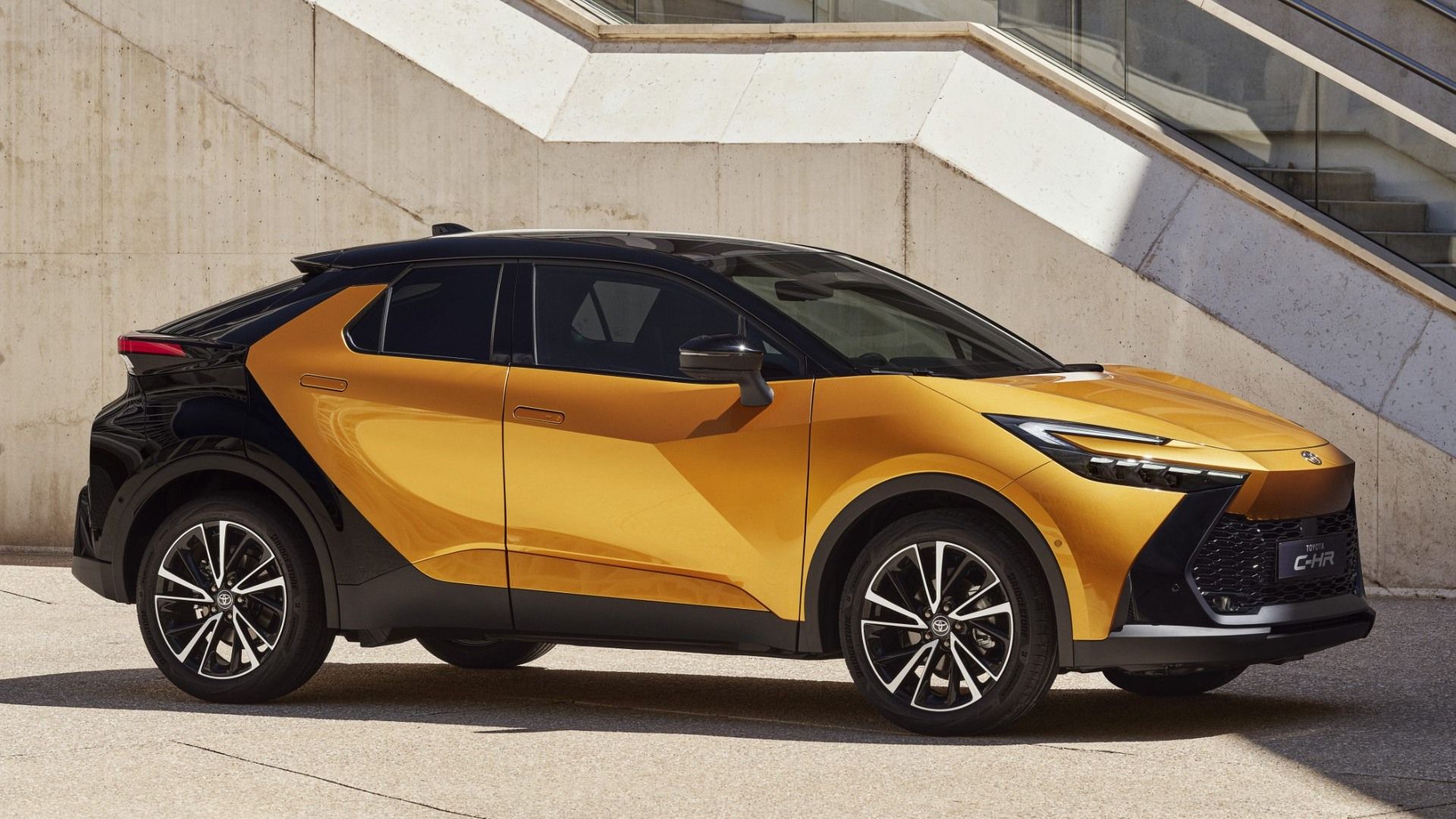
The C-HR features relatively soft suspension for a smooth, composed ride overall. For the most comfortable experience, opt for the Icon or Design trim levels, which come with 17-inch and 18-inch wheels, respectively—offering a more compliant ride than the 19-inch alloys standard on the top-spec Premiere Edition.
We haven’t yet tested the GR Sport model, which gets stiffer suspension and larger 20-inch wheels, but it’s expected to deliver the firmest ride in the lineup. Still, even lower trims aren’t flawless—sharp road imperfections occasionally jolt through the cabin both audibly and physically. In contrast, the Lexus LBX and especially the VW T-Roc tend to absorb such imperfections more effectively.
Both of those rivals also feel more planted on the road. The C-HR, by comparison, can feel a bit unsettled, particularly on undulating back roads where you might find yourself bouncing slightly like a bobblehead. That said, the ride never crosses into harsh or jarring territory. On highways, however, the C-HR still doesn’t feel as composed or settled as the LBX or T-Roc.
The PHEV version of the C-HR features a slightly revised suspension setup to accommodate the added weight of its battery, electric motor, and charging components. It rides a bit firmer than the regular hybrid, but overall maintains a similar feel in terms of comfort and compliance.
3. BMW X4 – 39.3 inches (Front Headroom)
The BMW X4’s coupe-SUV styling prioritizes aesthetics over space. Although it shares much of its platform with the X3, the sloped roof cuts significantly into headroom.
Taller drivers might find the front tolerable, but the rear seats are noticeably tight. It’s a trade-off between style and space.
The BMW X4 is a standout in the compact luxury SUV segment. While the more conventional BMW X3 shares the same excellent powertrains and sharp chassis tuning, the X3 is also less expensive, offers more rear headroom, and provides a larger cargo area.
However, for those who want a more stylish and distinctive option, the rakish design of the X4 delivers exactly that. It caters to buyers who prioritize aesthetics and uniqueness over sheer practicality.
The X4 xDrive30i comes equipped with a 248-horsepower turbocharged four-cylinder engine, while the more performance-oriented X4 M40i features a 382-horsepower turbocharged inline-six. All-wheel drive is standard across the board, and the interior is both businesslike and upscale, offering enough room for four adults, or five if they don’t mind getting a bit close.

Compared to its key competitors—the Mercedes GLC Coupe and Audi Q5 Sportback—the X4 is more performance-focused. For those who want to go all-in on power, BMW also offers the 503-horsepower X4 M, which is reviewed separately.
While the M40i’s turbocharged inline-six offers exhilarating performance, the base xDrive30i’s turbo-four provides more than enough power for most buyers and delivers better fuel efficiency. We recommend the 30i trim paired with the Premium package, which now includes heated seats and adds features like a head-up display.
Under the hood, the X4 xDrive30i uses a 2.0-liter turbocharged four-cylinder engine generating 248 horsepower and 258 lb-ft of torque.
For those wanting something more potent, the X4 M40i is powered by a 3.0-liter turbocharged inline-six producing 382 horsepower and 365 lb-ft of torque. The engine sounds as strong as it feels, especially with standard launch control adding to the fun.
Both trims utilize an eight-speed automatic transmission that sends power to all four wheels. Regardless of which version you choose, the X4 impresses with a sporty driving character and a refined ride, making it a compelling choice for anyone looking to combine performance and luxury in a compact SUV.
4. Jeep Compass – 39.2 inches (Front Headroom)
The Jeep Compass is positioned as a compact off-roader, but it compromises headroom for its compact stature.
With just over 39 inches up front and less in the rear, taller passengers might need to slouch or adjust the seat uncomfortably low. It’s more suited for average-height occupants.
Like the navigation tool it takes its name from, the Jeep Compass offers a glimpse of where the brand is headed. Jeep continues to lean heavily into its legacy of off-road capability, making sure you remember it with small but intentional design details—such as the motif of a post-war 4×4 ‘climbing’ the windscreen pillar.
However, in practical terms, the Compass competes in the crowded and competitive small SUV segment, alongside models like the Jeep Avenger and Jeep Renegade. Of the three, the Compass is the largest and most expensive, inching into the same premium territory as the Range Rover Evoque.
Unlike the Evoque, though, the Compass has dropped diesel from its powertrain lineup and now offers only petrol-powered options: a mild hybrid and a plug-in hybrid (PHEV). Only the PHEV comes with four-wheel drive. In this review, we’ll cover how it drives, how practical it is, and whether it can go toe-to-toe with the top performers in its class.
The Jeep Compass is ready for light off-road duties, but it struggles on the road due to an unsettled ride, noisy engines, an underwhelming interior, and a price tag that doesn’t quite match the value offered.
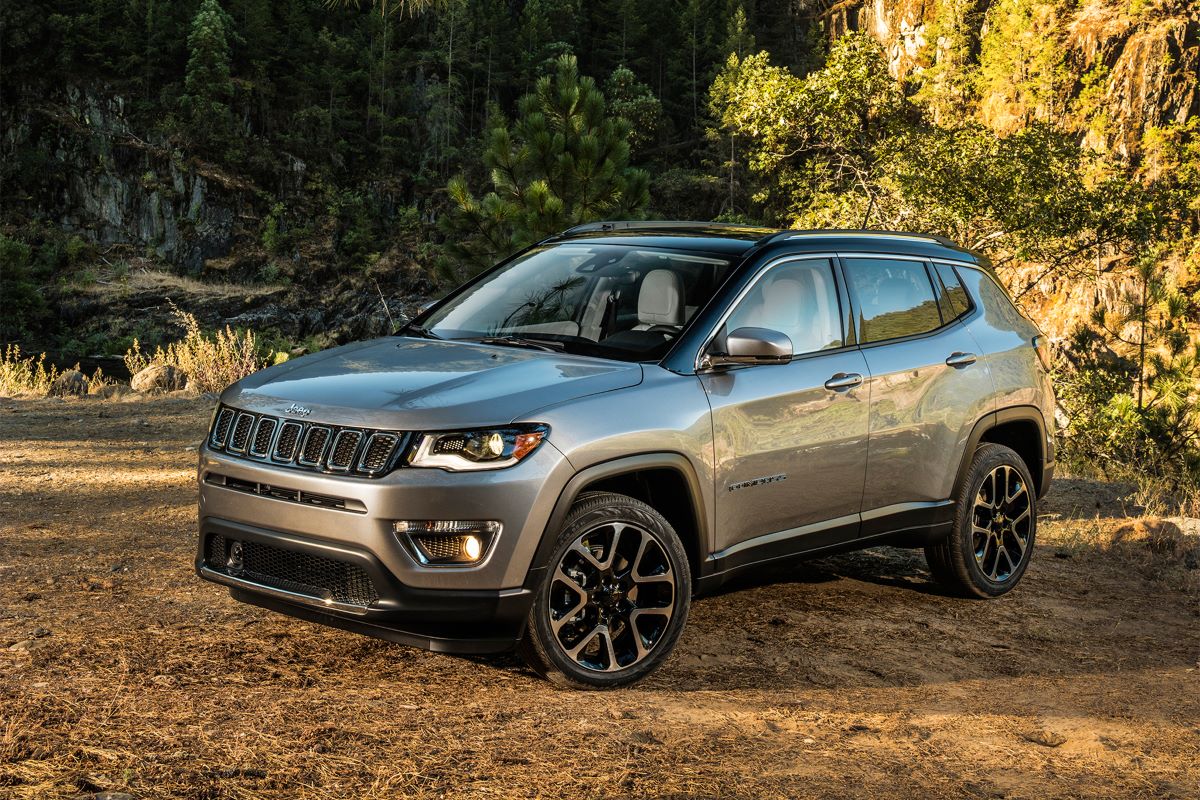
If you want four-wheel drive and stronger performance, the 4xe plug-in hybrid is your best option. It can be fuel-efficient when you keep the battery charged, which is a big plus in everyday driving.
Among its positives, the Compass does offer off-road capability, decent interior space, and solid equipment levels across the range. However, it’s let down by coarse engines, a relatively small boot for its class, and subpar cabin quality compared to rivals.
The range starts with the e-Hybrid, which uses a 128bhp 1.5-litre petrol engine paired with a mild hybrid system, automatic gearbox, and front-wheel drive.
Its official 0-62mph time is 10.0 seconds, putting it on par with the Peugeot 3008’s base powertrain, but lagging behind even the slowest Range Rover Evoque. It performs adequately in city environments but lacks urgency on faster roads or when carrying a heavier load.
The 4xe PHEV version improves things on paper with a quicker 0-62mph time of 7.3 seconds. This is thanks to its combination of a 1.3-litre petrol engine and electric motor that together produce up to 237bhp.
Still, in real-world driving, it doesn’t feel particularly fast. Like the e-Hybrid, it’s only available with an automatic transmission. The hybrid system works quietly in town under electric power alone, but at higher speeds, it tends to hold back in an effort to save fuel.
Getting the full power output requires a deep press of the accelerator, which becomes frustrating when trying to merge onto motorways or overtake.
On a full charge of its 11.4kWh battery, the Compass 4xe can travel around 32 miles in electric-only mode—less than the Range Rover Evoque P300e, which offers up to 39 miles. Road manners are also not the Compass’s strong suit.
It’s prone to being unsettled by uneven road surfaces. While it doesn’t toss passengers around as much as the Renegade, it still lacks the polished ride quality of smoother rivals like the Peugeot 3008 or Skoda Karoq.
The steering feels too light and lacks precision, which is fine around town but makes the vehicle feel uncertain at higher speeds. Body roll in corners doesn’t help either, making the Compass feel less stable when navigating twisty roads. Wind and road noise are passable for the class, but engine refinement leaves much to be desired.
The e-Hybrid drones loudly under hard acceleration, and the 4xe’s petrol engine kicks in with a coarse note and noticeable vibrations through the steering wheel—more in line with an old diesel than a modern hybrid.
The PHEV does benefit from regenerative braking, which helps recharge the battery during deceleration. However, the transition from regenerative to mechanical braking can feel jarring at low speeds, making it seem as though the car is about to slam on the brakes if you’re not gentle with the pedal.
If you’re planning to tackle rougher terrain, the 4xe’s four-wheel-drive system, mud and snow tyres, and slightly raised ride height make it a viable option. Opting for the Trailhawk trim enhances that capability with the addition of a Rock drive mode and underbody protection—ideal for more adventurous driving conditions.
5. Infiniti QX55 – 39.9 inches (Front Headroom)
The Infiniti QX55 is a luxury crossover coupe that inherits its sloping roofline from sportier designs. While it looks sleek and modern, the low ceiling can feel confining for tall drivers and passengers alike.
The back seats suffer the most, with a noticeable drop in headspace, making it less practical as a family vehicle. SUVs are often praised for offering more space than sedans, but not all are created equal when it comes to headroom.
The QX55 is part of a rising trend among SUVs that prioritize style over maximum utility, transforming traditional models into sleeker silhouettes by trimming the cargo space.
It’s essentially a more visually striking version of the QX50, sharing its turbocharged 2.0-liter four-cylinder engine and continuously variable automatic transmission. This engine features a complex variable-compression system designed to balance power and efficiency, but in practice, it falls short on both fronts.

Even with an underwhelming powertrain, the QX55 handles corners with surprising confidence and delivers a smooth, composed ride. However, if you’re considering coupe-style compact SUVs from German rivals like the Audi Q5 Sportback, BMW X4, or Mercedes-Benz GLC Coupe, you’ll find they not only outperform the QX55 but also offer interiors that feel more contemporary.
For those intrigued by the QX55’s design but needing something a bit larger, Infiniti is set to introduce the QX65—a sloped-roof version of the QX60 midsize SUV—that’s expected to follow the same sleek, coupe-inspired approach.
If you’re tall or regularly transport tall passengers, full-size models like the Ford Expedition Max or Chevrolet Tahoe are safe bets.
On the other hand, if style is your priority and you’re of average height, tighter-ceiling SUVs like the BMW X4 or Toyota C-HR might still suit your needs.
Always check the spec sheet and more importantly, take a seat behind the wheel before committing to a purchase.

